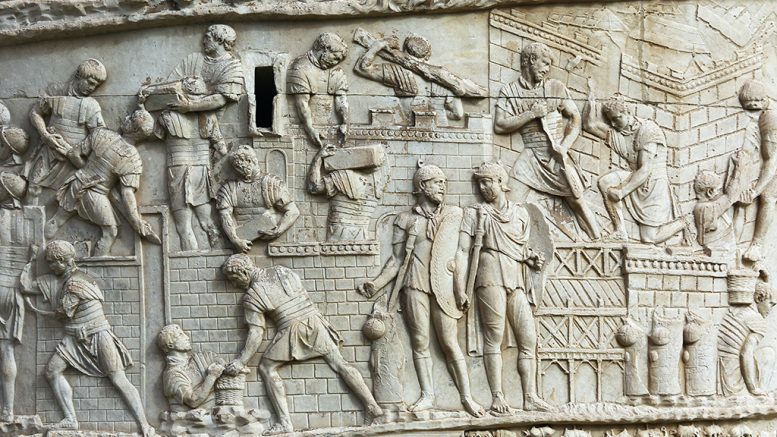In England, we have had festivals at this time of year since well before the Romans began their creeping conquest in AD43. The occupation of most of Britain was a done deal by AD60 following the defeat of Queen Boudica (leader of the Iceni in modern day Norfolk).
Back then we were celebrating pagan festivals, either the Anglo-Saxon Mōdraniht (Night of the Mothers) or Yuletide, which was a mid-winter festival originally observed by the Germanic peoples and connected with the Norse god Odin (the latter may have influenced the association with a white-bearded figure and reindeer). Yuletide lasted from what is now mid-November until early January, but the main celebrations focused on the three nights after the Winter solstice.
Christianity was brought to Europe by Constantine in the first half of the 4th century. This followed his succession as Emperor in 306 on the death of his father, Constantius, while they were both garrisoned in York (the spot where he was acclaimed by the legions is in the catacombs of York Minster).
Until then, the Romans had celebrated Saturnalia at this time of the year (December 17-23) in honour of the god Saturn. The festival included banquets, the giving of gifts and extravagant parties. Emperor Constantine subsequently amalgamated the various mid-winter festivals in the empire into a celebration of the birth of Christ.
Although the date of Jesus’s birth was unknown, the church in the early 4th century fixed the date as December 25, which corresponded to the date of the winter solstice in the Roman calendar.
The first recorded celebration in England of Christ’s birth and the name Christmas (Christ’s Mass) was not until 1038. Gift-giving at that time was more associated with Saint Nicholas of Myra (270-343), who was an early Christian bishop of Greek descent from the maritime city of Myra in Asia Minor (modern-day Demre in Turkey). His legendary habit of secret gift-giving gave rise to the traditional model of Santa Claus (a phonetic derivation of ‘Sinterklaas’, a legendary Dutch figure based on Saint Nicholas).
During the early Middle Ages, the poor and children were given gifts on Saint Nicholas’s name day, December 6. During the first half of the 16th century, however, the priest who led the Reformation in Europe, Martin Luther, propagated the moving of this gift-giving custom to Christmas, so that the focus would be on Christ, rather than on the veneration of a saint.
Even earlier gifts at this time of year are associated, of course, with “wise men from the East” paying homage to the baby Jesus in Bethlehem. Their gifts had particular significance, with gold referring to Jesus’s status as ‘King of the Jews’, frankincense (an incense) represented the infant’s divinity, and myrrh (an embalming oil) suggested Jesus’s mortality.
Almost 60 years ago (January 20, 1961), the 35th president of the United States, John F. Kennedy, gave an inspired inaugural address and urged Americans to “Ask not what your country can do for you, ask what you can do for your country”. After a disastrous year for the mining industry (as referenced in my recent Saint Barbara column), now might be a good time for the extractive sector to consider what three things it can do for a world in need of good cheer.
I have three suggestions (and feel free to offer others to The Northern Miner), centred on what metals we should be offering society, how we prove where they come from and how we conduct ourselves in their delivery.
The first gift would be an acceptance that the mining industry needs to deliver more reliable access to metals for sustainable development (not least batteries), rather than those destined for bank vaults. It shouldn’t be beyond the wit of our leaders to encourage (with politicians) the exploration and development of such metals, for example cobalt, in politically safe geographies. These metals are too important to the world to be left to the whim of metals traders and the vagaries of the market.
The second gift would be urgent adoption of blockchain technology to prove from where our metals and minerals are sourced. The timing is good; on December 15, the World Economic Forum’s Mining and Metals Blockchain Initiative released what it described as “a unique proof of concept to trace emissions across the value chain using distributed ledger technology”. This initiative is a collaboration with seven global companies that aims to accelerate an industry solution for supply chain visibility and environmental, social and corporate governance (ESG) requirements.
The last gift the mining industry should deliver at this festive time of year is a real commitment to ESG. We have a long way still to go in demonstrating our resolve, witness Rio Tinto’s catastrophic destruction of the Aboriginal Juukan Gorge caves in Western Australia. Our commitment needs to have teeth, and soon.
— Dr. Chris Hinde is a mining engineer and the director of Pick and Pen Ltd., a U.K.-based consulting firm he set up in 2018 specializing in mining industry trends. He previously worked for S&P Global Market Intelligence’s Metals and Mining division.


Be the first to comment on "The View From England: Time for the mining industry to consider its gifts to the world"